Xingyuan Bu
COIG-P: A High-Quality and Large-Scale Chinese Preference Dataset for Alignment with Human Values
Apr 07, 2025Abstract:Aligning large language models (LLMs) with human preferences has achieved remarkable success. However, existing Chinese preference datasets are limited by small scale, narrow domain coverage, and lack of rigorous data validation. Additionally, the reliance on human annotators for instruction and response labeling significantly constrains the scalability of human preference datasets. To address these challenges, we design an LLM-based Chinese preference dataset annotation pipeline with no human intervention. Specifically, we crawled and carefully filtered 92k high-quality Chinese queries and employed 15 mainstream LLMs to generate and score chosen-rejected response pairs. Based on it, we introduce COIG-P (Chinese Open Instruction Generalist - Preference), a high-quality, large-scale Chinese preference dataset, comprises 1,009k Chinese preference pairs spanning 6 diverse domains: Chat, Code, Math, Logic, Novel, and Role. Building upon COIG-P, to reduce the overhead of using LLMs for scoring, we trained a 8B-sized Chinese Reward Model (CRM) and meticulously constructed a Chinese Reward Benchmark (CRBench). Evaluation results based on AlignBench \citep{liu2024alignbenchbenchmarkingchinesealignment} show that that COIG-P significantly outperforms other Chinese preference datasets, and it brings significant performance improvements ranging from 2% to 12% for the Qwen2/2.5 and Infinity-Instruct-3M-0625 model series, respectively. The results on CRBench demonstrate that our CRM has a strong and robust scoring ability. We apply it to filter chosen-rejected response pairs in a test split of COIG-P, and our experiments show that it is comparable to GPT-4o in identifying low-quality samples while maintaining efficiency and cost-effectiveness. Our codes and data are released in https://github.com/multimodal-art-projection/COIG-P.
Can Large Language Models Detect Errors in Long Chain-of-Thought Reasoning?
Feb 26, 2025Abstract:Recently, o1-like models have drawn significant attention, where these models produce the long Chain-of-Thought (CoT) reasoning steps to improve the reasoning abilities of existing Large Language Models (LLMs). In this paper, to understand the qualities of these long CoTs and measure the critique abilities of existing LLMs on these long CoTs, we introduce the DeltaBench, including the generated long CoTs from different o1-like models (e.g., QwQ, DeepSeek-R1) for different reasoning tasks (e.g., Math, Code, General Reasoning), to measure the ability to detect errors in long CoT reasoning. Based on DeltaBench, we first perform fine-grained analysis of the generated long CoTs to discover the effectiveness and efficiency of different o1-like models. Then, we conduct extensive evaluations of existing process reward models (PRMs) and critic models to detect the errors of each annotated process, which aims to investigate the boundaries and limitations of existing PRMs and critic models. Finally, we hope that DeltaBench could guide developers to better understand the long CoT reasoning abilities of their models.
SuperGPQA: Scaling LLM Evaluation across 285 Graduate Disciplines
Feb 20, 2025Abstract:Large language models (LLMs) have demonstrated remarkable proficiency in mainstream academic disciplines such as mathematics, physics, and computer science. However, human knowledge encompasses over 200 specialized disciplines, far exceeding the scope of existing benchmarks. The capabilities of LLMs in many of these specialized fields-particularly in light industry, agriculture, and service-oriented disciplines-remain inadequately evaluated. To address this gap, we present SuperGPQA, a comprehensive benchmark that evaluates graduate-level knowledge and reasoning capabilities across 285 disciplines. Our benchmark employs a novel Human-LLM collaborative filtering mechanism to eliminate trivial or ambiguous questions through iterative refinement based on both LLM responses and expert feedback. Our experimental results reveal significant room for improvement in the performance of current state-of-the-art LLMs across diverse knowledge domains (e.g., the reasoning-focused model DeepSeek-R1 achieved the highest accuracy of 61.82% on SuperGPQA), highlighting the considerable gap between current model capabilities and artificial general intelligence. Additionally, we present comprehensive insights from our management of a large-scale annotation process, involving over 80 expert annotators and an interactive Human-LLM collaborative system, offering valuable methodological guidance for future research initiatives of comparable scope.
Equilibrate RLHF: Towards Balancing Helpfulness-Safety Trade-off in Large Language Models
Feb 17, 2025Abstract:Fine-tuning large language models (LLMs) based on human preferences, commonly achieved through reinforcement learning from human feedback (RLHF), has been effective in improving their performance. However, maintaining LLM safety throughout the fine-tuning process remains a significant challenge, as resolving conflicts between safety and helpfulness can be non-trivial. Typically, the safety alignment of LLM is trained on data with safety-related categories. However, our experiments find that naively increasing the scale of safety training data usually leads the LLMs to an ``overly safe'' state rather than a ``truly safe'' state, boosting the refusal rate through extensive safety-aligned data without genuinely understanding the requirements for safe responses. Such an approach can inadvertently diminish the models' helpfulness. To understand the phenomenon, we first investigate the role of safety data by categorizing them into three different groups, and observe that each group behaves differently as training data scales up. To boost the balance between safety and helpfulness, we propose an Equilibrate RLHF framework including a Fine-grained Data-centric (FDC) approach that achieves better safety alignment even with fewer training data, and an Adaptive Message-wise Alignment (AMA) approach, which selectively highlight the key segments through a gradient masking strategy. Extensive experimental results demonstrate that our approach significantly enhances the safety alignment of LLMs while balancing safety and helpfulness.
Chinese SimpleQA: A Chinese Factuality Evaluation for Large Language Models
Nov 13, 2024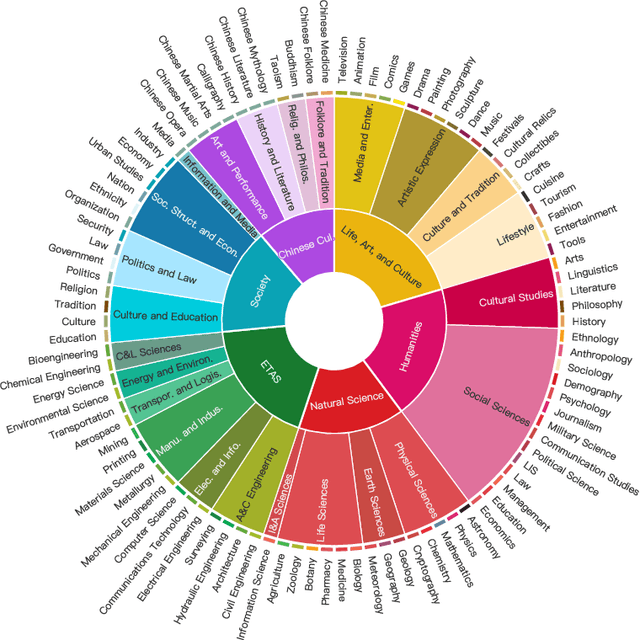


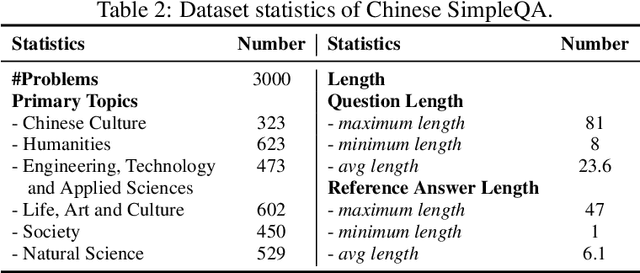
Abstract:New LLM evaluation benchmarks are important to align with the rapid development of Large Language Models (LLMs). In this work, we present Chinese SimpleQA, the first comprehensive Chinese benchmark to evaluate the factuality ability of language models to answer short questions, and Chinese SimpleQA mainly has five properties (i.e., Chinese, Diverse, High-quality, Static, Easy-to-evaluate). Specifically, first, we focus on the Chinese language over 6 major topics with 99 diverse subtopics. Second, we conduct a comprehensive quality control process to achieve high-quality questions and answers, where the reference answers are static and cannot be changed over time. Third, following SimpleQA, the questions and answers are very short, and the grading process is easy-to-evaluate based on OpenAI API. Based on Chinese SimpleQA, we perform a comprehensive evaluation on the factuality abilities of existing LLMs. Finally, we hope that Chinese SimpleQA could guide the developers to better understand the Chinese factuality abilities of their models and facilitate the growth of foundation models.
2D-DPO: Scaling Direct Preference Optimization with 2-Dimensional Supervision
Oct 25, 2024



Abstract:Recent advancements in Direct Preference Optimization (DPO) have significantly enhanced the alignment of Large Language Models (LLMs) with human preferences, owing to its simplicity and effectiveness. However, existing methods typically optimize a scalar score or ranking reward, thereby overlooking the multi-dimensional nature of human preferences. In this work, we propose to extend the preference of DPO to two dimensions: segments and aspects. We first introduce a 2D supervision dataset called HelpSteer-2D. For the segment dimension, we divide the response into sentences and assign scores to each segment. For the aspect dimension, we meticulously design several criteria covering the response quality rubrics. With the 2-dimensional signals as feedback, we develop a 2D-DPO framework, decomposing the overall objective into multi-segment and multi-aspect objectives. Extensive experiments on popular benchmarks demonstrate that 2D-DPO performs better than methods that optimize for scalar or 1-dimensional preferences.
Adaptive Dense Reward: Understanding the Gap Between Action and Reward Space in Alignment
Oct 23, 2024
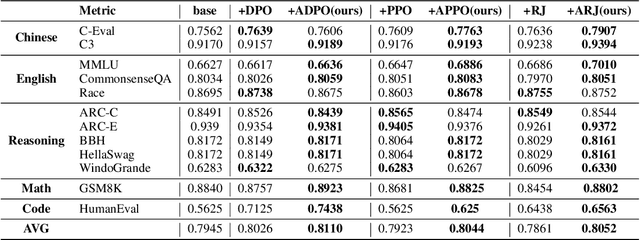
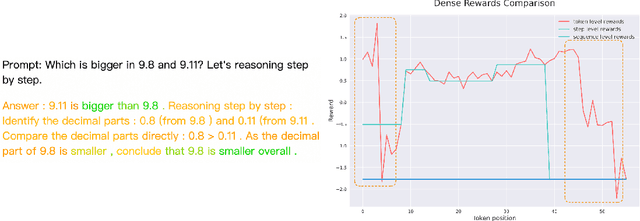
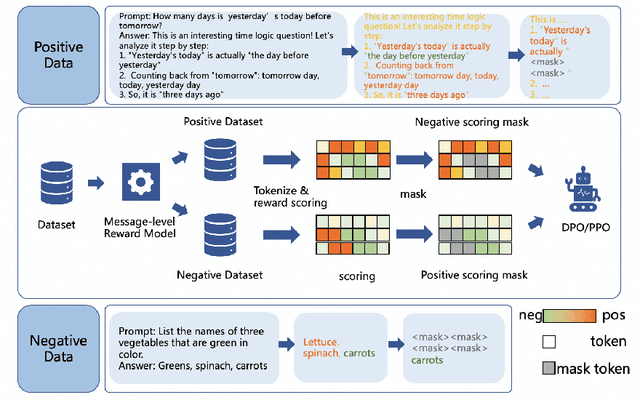
Abstract:Reinforcement Learning from Human Feedback (RLHF) has proven highly effective in aligning Large Language Models (LLMs) with human preferences. However, the original RLHF typically optimizes under an overall reward, which can lead to a suboptimal learning process. This limitation stems from RLHF's lack of awareness regarding which specific tokens should be reinforced or suppressed. Moreover, conflicts in supervision can arise, for instance, when a chosen response includes erroneous tokens, while a rejected response contains accurate elements. To rectify these shortcomings, increasing dense reward methods, such as step-wise and token-wise RLHF, have been proposed. However, these existing methods are limited to specific tasks (like mathematics). In this paper, we propose the ``Adaptive Message-wise RLHF'' method, which robustly applies to various tasks. By defining pivot tokens as key indicators, our approach adaptively identifies essential information and converts sample-level supervision into fine-grained, subsequence-level supervision. This aligns the density of rewards and action spaces more closely with the information density of the input. Experiments demonstrate that our method can be integrated into various training methods, significantly mitigating hallucinations and catastrophic forgetting problems while outperforming other methods on multiple evaluation metrics. Our method improves the success rate on adversarial samples by 10\% compared to the sample-wise approach and achieves a 1.3\% improvement on evaluation benchmarks such as MMLU, GSM8K, and HumanEval et al.
Online Learning of Multiple Tasks and Their Relationships : Testing on Spam Email Data and EEG Signals Recorded in Construction Fields
Jun 26, 2024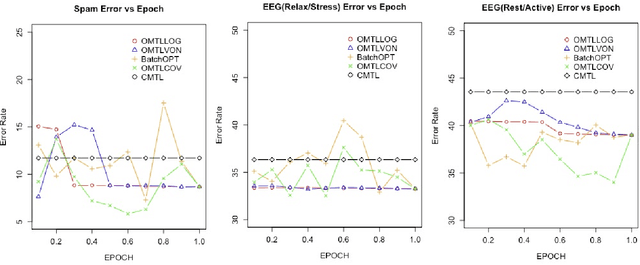
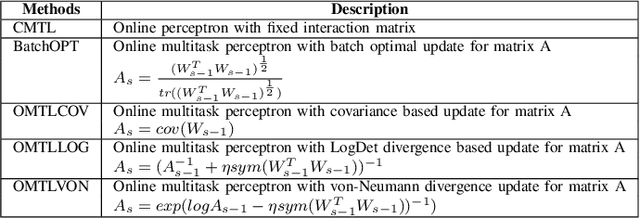

Abstract:This paper examines an online multi-task learning (OMTL) method, which processes data sequentially to predict labels across related tasks. The framework learns task weights and their relatedness concurrently. Unlike previous models that assumed static task relatedness, our approach treats tasks as initially independent, updating their relatedness iteratively using newly calculated weight vectors. We introduced three rules to update the task relatedness matrix: OMTLCOV, OMTLLOG, and OMTLVON, and compared them against a conventional method (CMTL) that uses a fixed relatedness value. Performance evaluations on three datasets a spam dataset and two EEG datasets from construction workers under varying conditions demonstrated that our OMTL methods outperform CMTL, improving accuracy by 1\% to 3\% on EEG data, and maintaining low error rates around 12\% on the spam dataset.
GraphReader: Building Graph-based Agent to Enhance Long-Context Abilities of Large Language Models
Jun 20, 2024Abstract:Long-context capabilities are essential for large language models (LLMs) to tackle complex and long-input tasks. Despite numerous efforts made to optimize LLMs for long contexts, challenges persist in robustly processing long inputs. In this paper, we introduce GraphReader, a graph-based agent system designed to handle long texts by structuring them into a graph and employing an agent to explore this graph autonomously. Upon receiving a question, the agent first undertakes a step-by-step analysis and devises a rational plan. It then invokes a set of predefined functions to read node content and neighbors, facilitating a coarse-to-fine exploration of the graph. Throughout the exploration, the agent continuously records new insights and reflects on current circumstances to optimize the process until it has gathered sufficient information to generate an answer. Experimental results on the LV-Eval dataset reveal that GraphReader, using a 4k context window, consistently outperforms GPT-4-128k across context lengths from 16k to 256k by a large margin. Additionally, our approach demonstrates superior performance on four challenging single-hop and multi-hop benchmarks.
Iterative Length-Regularized Direct Preference Optimization: A Case Study on Improving 7B Language Models to GPT-4 Level
Jun 17, 2024Abstract:Direct Preference Optimization (DPO), a standard method for aligning language models with human preferences, is traditionally applied to offline preferences. Recent studies show that DPO benefits from iterative training with online preferences labeled by a trained reward model. In this work, we identify a pitfall of vanilla iterative DPO - improved response quality can lead to increased verbosity. To address this, we introduce iterative length-regularized DPO (iLR-DPO) to penalize response length. Our empirical results show that iLR-DPO can enhance a 7B model to perform on par with GPT-4 without increasing verbosity. Specifically, our 7B model achieves a $50.5\%$ length-controlled win rate against $\texttt{GPT-4 Preview}$ on AlpacaEval 2.0, and excels across standard benchmarks including MT-Bench, Arena-Hard and OpenLLM Leaderboard. These results demonstrate the effectiveness of iterative DPO in aligning language models with human feedback.
 Add to Chrome
Add to Chrome Add to Firefox
Add to Firefox Add to Edge
Add to Edge